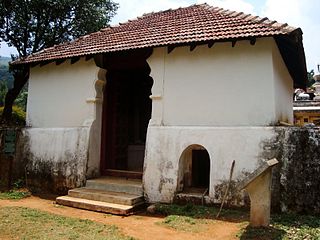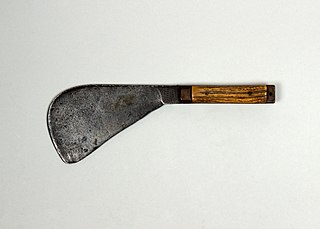Related Research Articles

The Kodava is an endangered Dravidian language and it is spoken in Kodagu district in Southern Karnataka, India. The term Kodava has two related usages. Firstly, it is the name of the Kodava language and culture followed by a number of communities from Kodagu. Secondly, within the Kodava-speaking communities and region (Kodagu), it is a demonym for the dominant Kodava people. Hence, the Kodava language is not only the primary language of the Kodavas but also of many other castes and tribes in Kodagu. The language has two dialects: Mendele and Kiggat.

Kodagu district is an administrative district in the Karnataka state of India. Before 1956, it was an administratively separate Coorg State, at which point it was merged into an enlarged Mysore State.

Wayanad is a district in the north-east of the Indian state of Kerala, with administrative headquarters at the municipality of Kalpetta. It is the only plateau in Kerala. The Wayanad Plateau forms a continuation of the Mysore Plateau, the southern portion of Deccan Plateau which links the Western Ghats with the Eastern Ghats. It is set high in the Western Ghats with altitudes ranging from 700 to 2100 meters. Vellari Mala, a 2,240 m (7,349 ft) high peak situated on the trijunction of Wayanad, Malappuram, and Kozhikode districts, is the highest point in Wayanad district. The district was formed on 1 November 1980 as the 12th district in Kerala, by carving out areas from Kozhikode and Kannur districts. An area of 885.92 km2 of the district is forested. Wayanad has three municipal towns—Kalpetta, Mananthavady and Sulthan Bathery. There are many indigenous tribes in this area. The Kabini River, a tributary of Kaveri River, originates at Wayanad. Wayanad district, along with the Chaliyar valley in neighbouring Nilambur in Malappuram district, is known for natural gold fields, which are also seen in other parts of the Nilgiri Biosphere Reserve. Chaliyar river, which is the fourth longest river of Kerala, originates on the Wayanad plateau. The historically important Edakkal Caves are located in Wayanad district.

Codava National Council, is a social organisation in the Indian state of Karnataka. Formerly CNC was known as KRMM. The KRMM demanded a separate statehood status for Kodagu until the 1990s. Later they scaled down their demand. Ever since they have been demanding a Kodava hill council in Kodagu. The CNC Organisation's President is Nandineravanda U. Nachappa Codava.

The Kodava people or Kodavas or Codavas are an ethno-linguistic group from the region of Kodagu in the southern Indian state of Karnataka, who natively speak the Kodava language. They are traditionally land-owning agriculturists and patrilineal, with martial customs. Kodavas worship ancestors and weapons. They used to worship swords, bows, arrows and later guns. Hence, Kodavas are the only ones in India permitted to carry firearms without a license.

Chikavira Rajendra or Chikka Vira Rajendra, was the last ruler of the Kodagu (Coorg) kingdom in South India. His actual name was Vira Rajendra, but this was the name of his uncle as well; as both of them were rulers of Kodagu, the prefix Chikka is used as a distinguisher. He was a son of Linga Rajendra II.
The town of Virajpet also spelled as Virajapete is the second town of the district of Kodagu (Coorg), in Karnataka. It is the main town of the Virajpet taluka, south of the district, in the Kerala-Karnataka border. The name is an abbreviation of Virarajendrapete after the former ruler of Kodagu, Virarajendra.

The district of Kodagu in present-day Karnataka comprises the area of the former princely state of the same name.
Karnataka is an Indian state. Several etymologies have been suggested for the name Karnataka. The region was popularly referred to as 'kar nata’ literally meaning black soiled county in Indian history. However, historically, the names Karnatak or Carnatic have been misapplied to refer to the regions in or beyond the Western Ghats as well as to a region in present-day Andhra Pradesh (Telangana). The other accepted derivative comes from the words kar and nādu meaning land of black soil, or from the words kar/karu/kari meaning 'Black' and Nāḍu meaning region/country, referring to the black soil of the area. One more derivative is "Karnad" meaning "land of Black soil" and other derivative is from Kannada word meaning that 'Kari' (ಕರಿ) meaning 'shore' and Sanskrit 'nataka' (नाटक) meaning dance or acting.

Nalknad Palace or Nalkunadu, called Naalnaad Aramane in the local Kodava language, is a palace located in the Kodagu district of the Indian state of Karnataka. It is located near a village named Yavakapadi and was built between the years 1792 and 1794 AD. This palace was the last refuge of the last of the Haleri kings of Kodagu, Chikka Veerarajendra before he was deposed by the British. The Kannada film Shanti, which has only a single actor, was shot in the surroundings of the palace.
The captivity of Kodavas (Coorgis) at Seringapatam was the period of capture, deportation, and imprisonment of Kodava Takk speaking Coorgis who rebelled against Tippu Sultan, the de facto ruler of the Kingdom of Mysore, they were caught during a number of attempts to suppress their rebellion in the 1780s.
Bācamāḍa Ḍevaiah Gaṇapati (1920–1997) was an Indian writer, scholar and journalist writing in English, Kannada and Kodava Takk, covering religion, anthropology and philosophy. He is particularly noted for his coverage of the Kodagu (Coorg) region and the Kodava ethno-linguistic group, his own birthplace and community.

Appaiah Swami or Sadguru Appayya Swami was a Hindu Indian spiritual master who lived in Virajpet town, in Kodagu, Karnataka, India.

Coorg State was a Part-C state in India which existed from 1950 to 1956. When the Constitution of India came into force on 26 January 1950, most of the existing provinces were reconstituted into states. Thus, Coorg Province became Coorg State. Coorg State was ruled by a Chief Commissioner with Mercara as its capital. The head of the government was the Chief Minister. Coorg State was abolished on 1 November 1956 as per the States Reorganisation Act, 1956 and its territory were merged with Mysore State. Presently, Coorg forms a district of Karnataka state.
The Kodava Maaple, also known as Jamma Maaple, is a Muslim community residing in Kodagu district of Karnataka in southern India. They are Sunnis of the Shafi'i madhab, and contract marriage alliances with Mappilas and Bearys. They speak Malayalam, although now they do follow some Mappila and Beary customs also.

Gundugutti M. Manjanathaya was an Indian freedom fighter and politician. Born as G. M. Manjanath, he was a prominent coffee planter and lived in the village of Gundugutti in Somwarpet taluk in Kodagu district.

Mysuru Mithra is an Indian Kannada language morning daily newspaper published from Mysore, India. A regional newspaper, it covers five districts: Mysuru, Mandya, Kodagu, Hassan and Chamarajanagar. This newspaper was launched in 1978. Its founder, editor and publisher is entrepreneur and writer K B Ganapathy.

Ayudha katti is an indigenous weapon of war and tools to the Kodava people of Kodagu, in the state of Karnataka, India. The ayudha katti is developed from an implement used to cut through dense undergrowth. Unlike most blades, the ayudha katti is worn without a sheath.
Marasimha II Satyavakya was a king of the Western Ganga Dynasty, 23rd in the succession. He was the successor of Marulaganga Neetimarga, his half-brother who reigned 961–963. He was succeeded by Rachamalla IV Satyavakya, his eldest son. He was a vassal of the declining Rashtrakuta empire and served them until their collapse.
References
- ↑ Sathyan, B N (1965). Mysore State Gazetteer: Coorg District. Mysore: Director of Print., Stationery and Publications at the Government Press.
- 1 2 3 M P, Nitin Kushalappa (13 February 2023). Dakshin: South Indian Myths and Fables Retold. Penguin Random House India Private Limited. ISBN 978-93-5492-932-8 . Retrieved 15 June 2023.
- 1 2 3 Richter, G (1870). Manual of Coorg. Mangalore: Stolz. pp. 216–224.
- 1 2 3 4 Mögling, Herrmann (1855). Coorg Memoirs. Wesleyan Mission Press. pp. 13–26.
- ↑ "Gazetteer of the Bombay Presidency". Gazetteer of the Bombay Presidency. XV Part II: 79. 1883 – via Government Central Press.
- ↑ Moraes, George M. (1931). The Kadamba Kula: A history of ancient and medieval Karnataka. Bombay.
{{cite book}}: CS1 maint: location missing publisher (link) - ↑ Ganapathy, B D (1967). Kodavas (Coorgs), Their Customs and Culture. p. 4.
- ↑ Subbayya, K K (1978). Archaeology of Coorg. Geetha Book House. p. 170.
- ↑ Belfour, Edward (1883). The Cyclopaedia of India and of Eastern and Southern Asia. Volume 2. Akademische Druck-u. Verlagsanstalt. p. 263.
- ↑ Karnataka State Gazetteer, Vol 1. Director of Print, Stationery and Publications at the Government Press. 1965. p. 40.
- ↑ Sathyan, B N (1965). Mysore State Gazetteer: Coorg District. Mysore: Director of Print., Stationery and Publications at the Government Press. pp. 39–40.
- ↑ Rao, B. Surendra (1998). Coorg Invented. Forum for Kodagu Studies. p. 46.
- ↑ Kamath (1993). Karnataka State Gazetteer: Volume 20. p. 2.
- ↑ Imperial Gazetteer of India: Mysore and Coorg. Usha. 1985. p. 278.
- ↑ "Bulletin of the Anthropological Survey of India". Anthropological Survey of India. Director, Anthropological Survey of India, Indian Museum. 25: 22. 1980.
- ↑ Sreenivasa Murthy, H. V.; Ramakrishnan, R. (1977). A History of Karnataka, from the Earliest Times to the Present Day. S. Chand. p. 304.